Like a hidden map, Scottsdale’s trails unwind into surprising desert views and varied difficulty levels. You’ll find family-friendly loops, short geological showcases, and steep summit scrambles within a half hour’s drive. I’ll point out the best routes for fitness, scenery, or a quick outdoor reset, with practical tips on timing, water, and trail etiquette—so you can pick the right hike and get out there safely.
Pinnacle Peak Trail
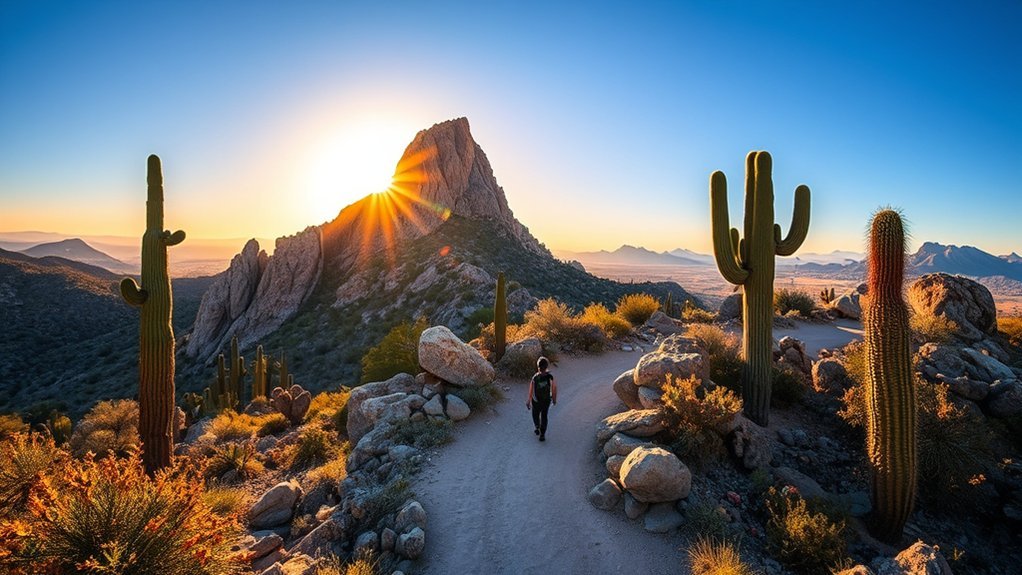
Tackle Pinnacle Peak Trail for a solid, family-friendly hike with big rewards: a 1.75-mile out-and-back route (about 2.5 miles round-trip) that gains roughly 600 feet and offers sweeping desert and mountain views without technical scrambling. You’ll follow a well-marked, switchback trail with stone steps and handrails in spots; the path is rocky but maintained, so wear sturdy shoes and watch your footing after rain. Start early to avoid midday heat and bring at least a liter of water per person, plus sun protection—hat, sunglasses, and SPF. Dogs are allowed on leash, and rest benches appear at viewpoints for quick breaks and photos. You’ll encounter moderate crowds on weekends; parking fills early, so arrive before 8 a.m. or aim for weekdays. Stay on trail to protect fragile desert plants and cacti, and pack out trash. The summit provides a satisfying 360-degree vista that makes the steady climb worthwhile without technical gear.
Camelback Mountain — Echo Canyon Trail
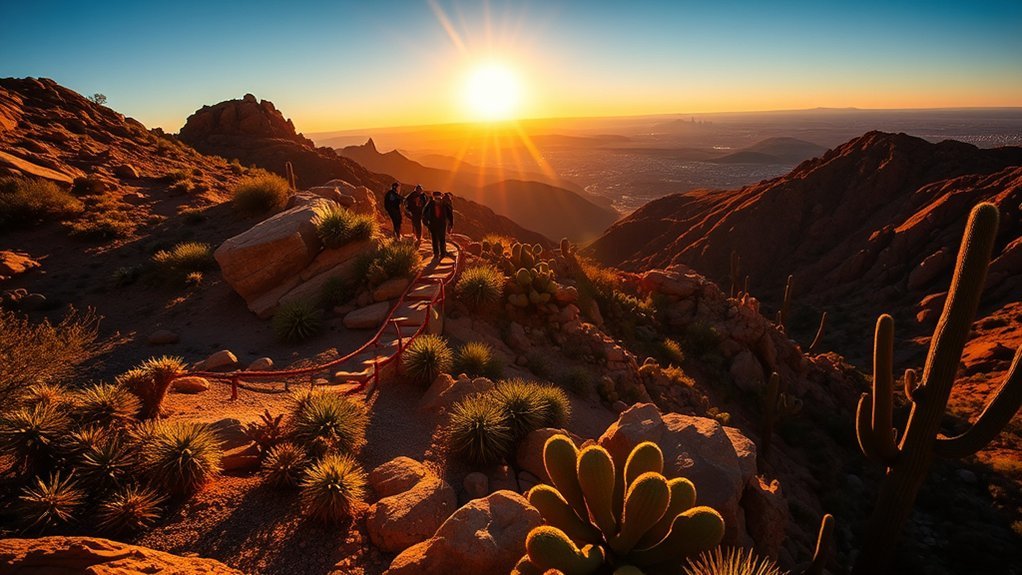
Often crowded but always rewarding, Camelback Mountain’s Echo Canyon Trail is a steep, strenuous 1.2-mile ascent (about 2.4 miles round-trip) that climbs roughly 1,300 feet through rocky switchbacks and exposed sections with handrails and fixed chains. You’ll need sturdy shoes, plenty of water, sun protection, and a head for heights; start early to avoid heat and crowds. The trail is short but intense—expect heavy breathing, short breaks, and careful footing on rock steps and ladder-like sections. At the summit you get panoramic city and desert views that justify the effort. Be aware of seasonal closures and obey posted rules; rescues happen when hikers underestimate the route. If you’re moderately fit and cautious, you’ll complete it in 1–2 hours round-trip. Use the table below to compare quick facts before you go.
| Distance | Elevation Gain | Difficulty |
|---|---|---|
| 1.2 mi one-way | ~1,300 ft | Strenuous |
| 2.4 mi round-trip | Exposed sections | Technical moves |
Lost Dog Wash Trail to Tom’s Thumb
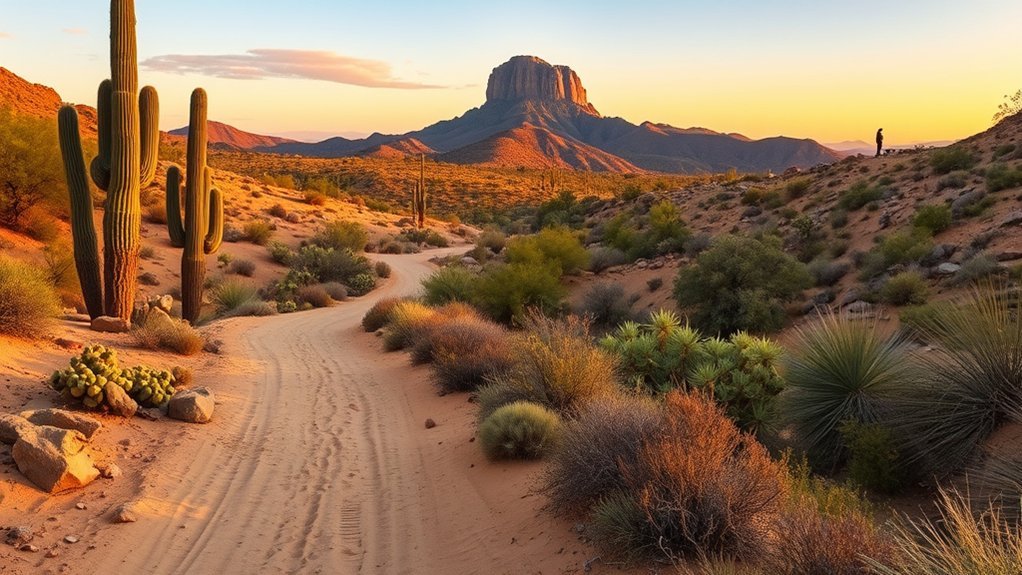
Start on the Lost Dog Wash Trail and follow the connector to Tom’s Thumb for a 4.6–6 mile out-and-back that gives you classic Sonoran Desert terrain. Expect moderate to strenuous sections with rocky footing and a few short scrambles, so plan 2–4 hours depending on pace and breaks. You’ll be rewarded with sculpted granite fins, sweeping valley views, and strong opportunities for sunrise or late-afternoon light.
Trail Overview
If you’re hiking from Lost Dog Wash Trail toward Tom’s Thumb, you’ll follow a well-marked route that gains steady elevation through classic Sonoran Desert terrain, rocky outcrops, and saguaro-studded washes. You’ll stay on a clearly defined trail that switches between packed dirt, gravel, and rocky steps; occasional cairns and signage keep you on course. Expect exposed ridge sections with broad views of the valley and nearby granite fins as you approach Tom’s Thumb’s distinctive rock formation. There are short side scrambles and a few narrow passages where you’ll need sure footing. Water sources aren’t available, so carry adequate supplies. Trail junctions are signed; if you miss one, backtrack a short distance to reconnect. Leave no trace and watch for wildlife.
Difficulty & Timing
Because the trail gains about 1,000 feet over roughly 4–5 miles round trip, you should expect a moderate to moderately strenuous outing depending on fitness and pace. You’ll climb steady switchbacks and encounter rocky sections that slow you; allow extra time for brief rests and navigation. Plan for 2.5–4 hours round trip: faster hikers finish near the low end, casual hikers take longer. Start early in summer to avoid heat, and aim for mid- to late-morning or late afternoon in cooler months. Bring at least 1 liter of water for shorter outings and 2+ liters in heat, plus sun protection and snacks. Trail conditions can add time after rain or during busy weekends, so factor in parking and crowds.
Scenic Highlights
What will catch your eye first along the Lost Dog Wash Trail to Tom’s Thumb is the dramatic contrast between broad Sonoran Desert valleys and the jagged granite outcrops that dominate the trail’s upper reaches. You’ll notice saguaro silhouettes against wide skies, creosote-scented washes, and seasonal bursts of wildflower color after winter rains. As you climb, granite boulders shift the palette to warm orange and gray, offering natural viewpoints and scramble opportunities. Look for panoramic vistas of Phoenix suburbs below and distant mountain ranges; these are best at morning or late afternoon light. Wildlife sightings include jackrabbits, lizards, and occasional raptors. Bring a camera, water, and sun protection—views reward effort, but exposure and heat make preparation essential.
McDowell Sonoran Preserve — Marcus Landslide Trail
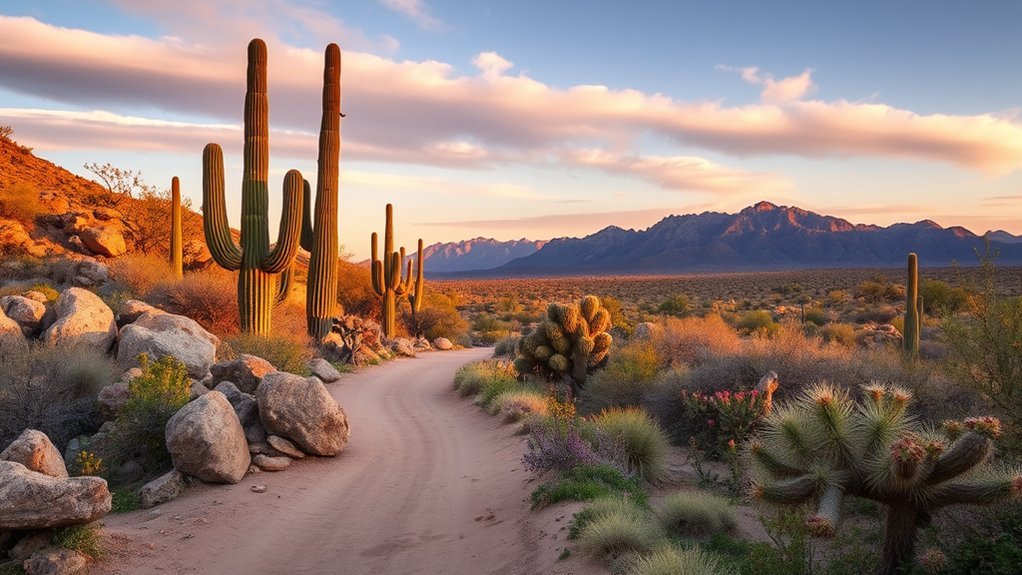
Start at the Marcus Landslide Trailhead and you’ll find a short, steep route that delivers dramatic desert scenery and a unique geologic feature—the landslide scarp—without requiring a long commitment. You’ll climb roughly 200 feet over rocky, compacted dirt to an overlook that frames the scar and surrounding boulder fields. The trail is about 1.6 miles round-trip if you follow the main out-and-back; expect loose rock, some narrow sections, and a few switchbacks.
Bring sturdy shoes, sun protection, and at least a liter of water per person—shade is minimal. Early morning or late afternoon hikes reduce heat and improve views. Dogs are allowed on leash, and the trail connects with other routes if you want to extend your route; check maps before branching off. Practice Leave No Trace: pack out trash and avoid climbing unstable sections of the scarp. The hike’s compact length and striking geology make it a practical choice when you want a quick, scenic desert workout.
Brown’s Ranch Trail Loop
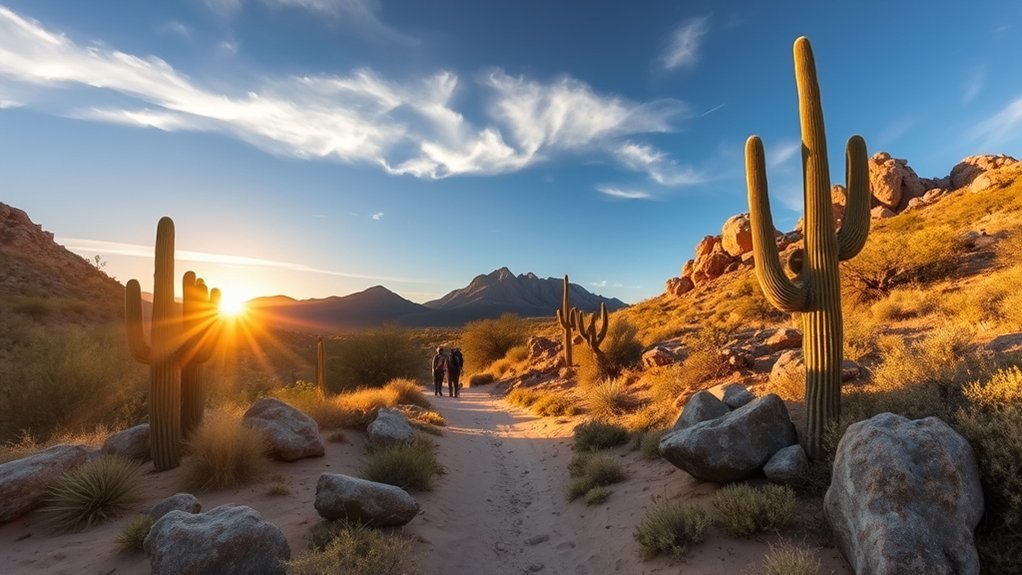
Often busy on weekends, the Brown’s Ranch Trail Loop delivers a moderate, family-friendly desert hike with wide, well-maintained paths, scenic saguaro-lined washes, and good views of the McDowell Mountains. You’ll follow a roughly 4.4-mile loop that’s mostly packed dirt and gravel, easy to navigate with kids or dogs (on leash). Elevation gain is gentle, so pace yourself for heat rather than steep climbs. Bring at least one liter of water per person in cooler months and more in summer; sun protection and sturdy shoes are essential. Trailheads offer limited parking and restrooms at the main staging area; arrive early on weekends to secure a spot. Wildlife sightings include lizards, rabbits, and occasional birds of prey — keep distance and don’t feed animals. The route connects to several shorter spurs if you want to shorten the outing. Leave no trace: pack out trash and stay on designated trails to protect fragile desert plants.
Gateway Loop Trail at McDowell Mountain Regional Park
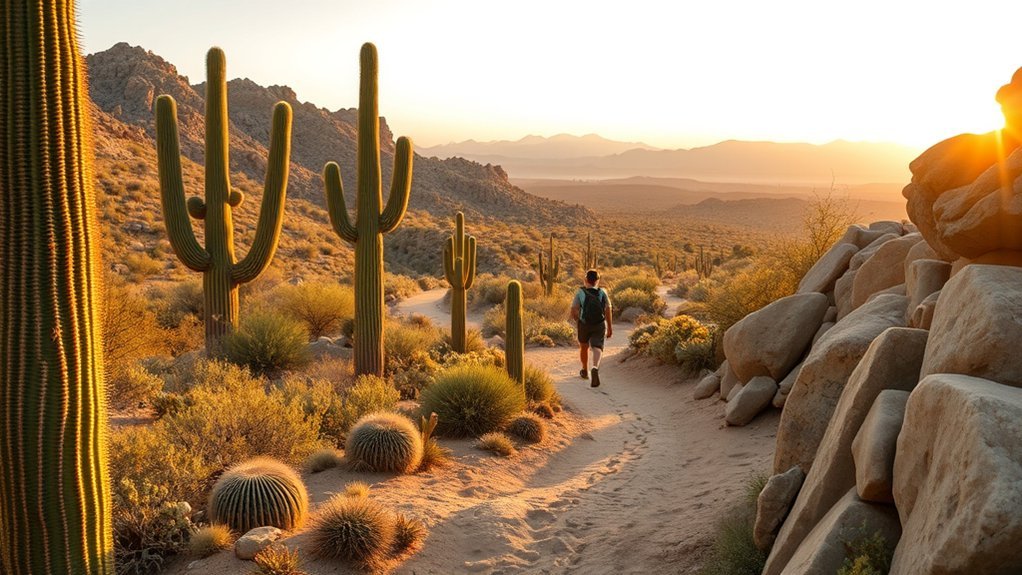
If you enjoyed the wide, family-friendly paths at Brown’s Ranch, you’ll find the Gateway Loop Trail at McDowell Mountain Regional Park similarly accessible but with a bit more variety in terrain and scenery. You’ll cover about 4.5 miles on a well-marked loop that mixes packed dirt, short rocky sections, and gentle climbs. The elevation gain is moderate, so it’s suitable for most hikers with basic fitness; poles can help on steeper switchbacks. Expect classic Sonoran views—saguaro, creosote, and granite outcrops—and good opportunities for birdwatching and photography without the crowds of nearby trails. Start early to avoid midday heat, bring at least a liter of water per person, sun protection, and sturdy shoes. Dogs on leash are allowed, and restrooms and picnic areas are available at the trailhead. If you want a reliable, varied half-day outing close to Scottsdale, the Gateway Loop delivers practical scenery and a manageable workout.
Scottsdale’s Sunset Trail to Brown’s Mountain
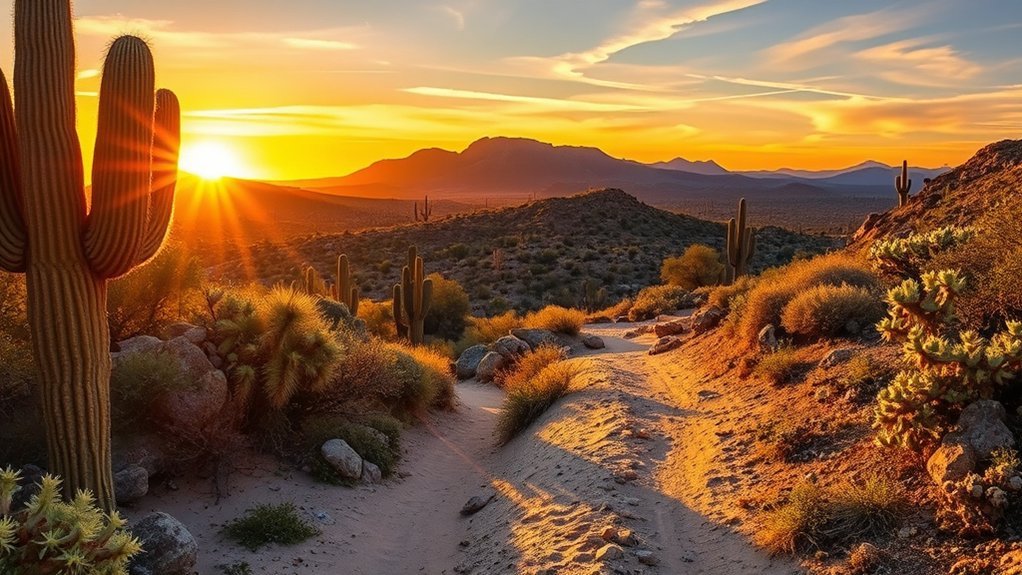
Frequently chosen by local hikers, Scottsdale’s Sunset Trail to Brown’s Mountain delivers a compact but rewarding workout: about 3.5 miles round-trip with steady climbs, rocky steps, and a final scramble to a panoramic summit. You’ll start on a well-marked path that gains elevation quickly, so set a steady pace and use trekking poles if you need extra stability. Water and sun protection are non-negotiable; shade is scarce. The summit offers 360-degree views of the Valley, a good spot for a short break and photos before heading back.
| Feature | Difficulty | Tip |
|---|---|---|
| Distance | 3.5 miles RT | Pace conservatively on climbs |
| Elevation Gain | ~800 ft | Carry 1L+ water per person |
| Trail Surface | Rocky, uneven | Wear sturdy shoes, watch footing |
| Best Time | Sunrise/sunset | Avoid midday heat, check weather |
Four Peaks Vista Trail at Usery Mountain Regional Park
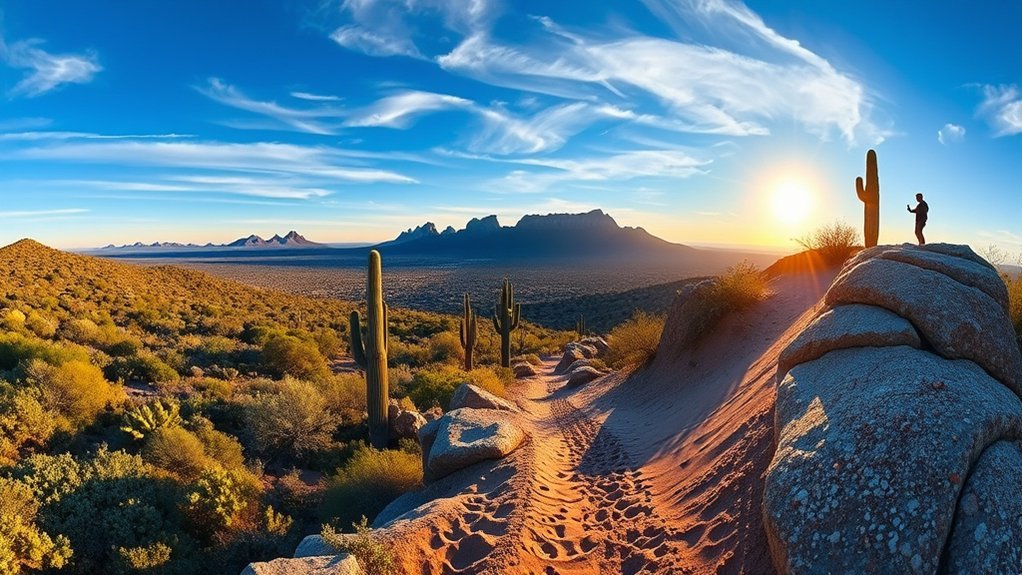
You’ll find the Four Peaks Vista Trail at Usery Mountain Regional Park is a moderate 4–5 mile out-and-back with rocky, uneven terrain and occasional steep sections, so wear sturdy shoes and bring trekking poles if you need extra stability. Plan your hike for early morning or late afternoon in cooler months to avoid heat and catch the best views of the Four Peaks; summer afternoons are dangerously hot and should be avoided. Check weather and park hours before you go so you can time your outing for clear vistas and safe conditions.
Trail Details and Terrain
When you set out on the Four Peaks Vista Trail at Usery Mountain Regional Park, expect a steady 3.5-mile out-and-back route with about 600 feet of elevation gain that rewards hikers with wide desert vistas and clear views of the Four Peaks range. The singletrack is firm-packed with occasional rocky sections and short, steeper pitches; you’ll cross gentle washes and navigate switchbacks that open onto broad viewpoints. Trail markers are regular but bring attention to footing on loose gravel. Vegetation is classic Sonoran — saguaro, creosote, the occasional palo verde — providing sparse shade and good sightlines. Wear supportive shoes and use poles if you want extra stability on descents.
- Surface: compact dirt with rocky patches.
- Grade: steady, moderate climbs.
- Navigation: well-marked, straightforward.
Best Times to Hike
Typically, the best times to hike Four Peaks Vista Trail are during the cooler months — late fall through early spring — when daytime highs stay comfortable and mornings are crisp; aim for early morning starts to avoid mid-day heat and to catch clearer views of the Four Peaks. You’ll want to check sunrise times and weather, bring layers for chilly mornings that warm quickly, and start before the park fills on weekends. Hydrate well, carry sun protection even in cool months, and plan shorter outings if forecasted winds or storms appear. Use this quick reference before you go:
| Season | Best Window | Notes |
|---|---|---|
| Fall | Oct–Nov | Cooler, fewer crowds |
| Winter | Dec–Feb | Crisp mornings, clear views |
| Spring | Mar–Apr | Wildflowers, warming temps |
Hieroglyphic Trail at Spur Cross Ranch Conservation Area
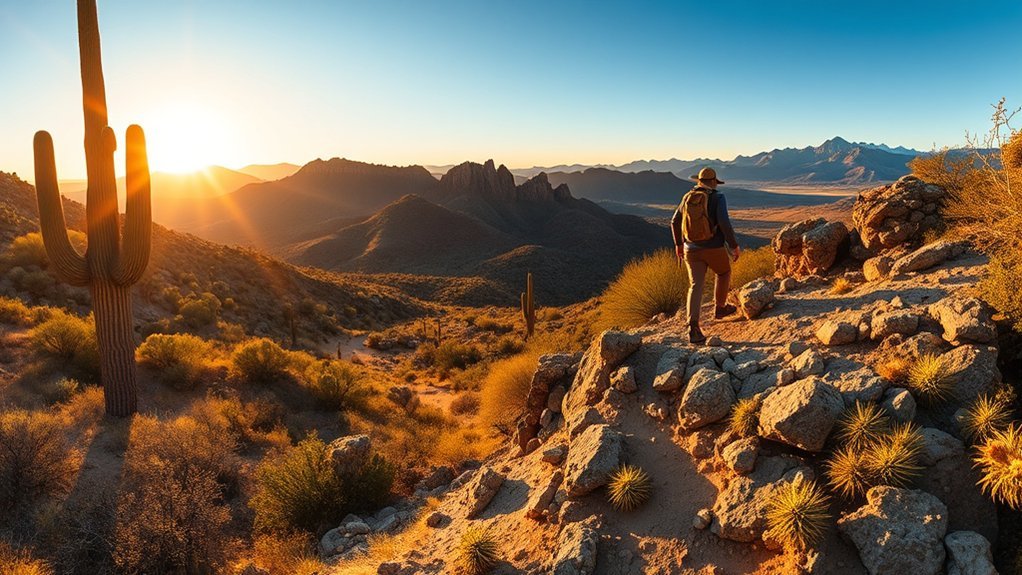
Set out on the Hieroglyphic Trail at Spur Cross Ranch Conservation Area to see ancient petroglyphs framed by saguaros and rugged desert ridges. You’ll follow a short, well-marked loop that’s about 1.3 miles if you stick to the primary path, making this a great half-hour outing with stops. The petroglyph panel sits near a wash; please stay on established trails and don’t touch the rock art to help it endure.
Set out on the Hieroglyphic Trail at Spur Cross to view ancient petroglyphs amid saguaros and desert ridges.
- Trail basics: moderate footing with some rocky sections, minimal shade—bring water, a hat, and sturdy shoes.
- Best timing: early morning or late afternoon to avoid heat and get softer light for photos; winter offers milder temps.
- What to expect: native plants, desert wildlife sightings, and clear interpretive signs explaining cultural significance.
You’ll find limited facilities—use the small trailhead lot and pack out trash. Respect private property boundaries around the conservation area.
Trail to Bell Pass and the Arizona Canal via Granite Mountain
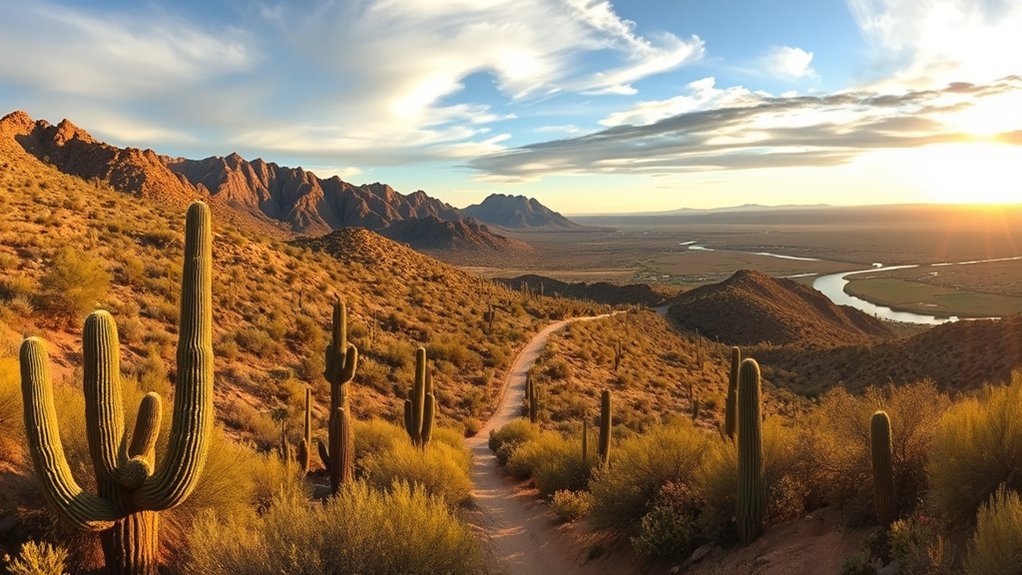
After enjoying the close-up history of the Hieroglyphic Trail, head east to Granite Mountain for a longer route that links rugged ridgelines with a surprisingly green endpoint at the Arizona Canal. You’ll begin on rocky switchbacks that climb quickly, so wear sturdy shoes and bring ample water; temperatures and exposure rise fast. The trail follows quartz-veined granite, offers wide desert panoramas, and narrows approaching Bell Pass where footing can be loose—use trekking poles if you need extra stability. At Bell Pass you’ll find a natural saddle and a good spot to rest, photograph the valley, and plan the descent toward the canal. The return moves from wild desert into surprisingly maintained canal paths lined with mesquite and cottonwood—ideal for cooling down and stretching your legs. Expect varied terrain, about 6–9 miles depending on chosen connectors, moderate difficulty, and limited shade. Start early, check trail conditions, and leave no trace.
Frequently Asked Questions
Are Dogs Allowed on These Trails?
Yes — you can bring dogs on many trails, but they must stay leashed, owners pick up waste, and some sensitive or rocky sections restrict pets; check each trail’s rules and seasonal advisories before heading out to avoid fines.
What Is the Best Time of Year to Hike Safely?
Spring and fall are best — they’ll give you mild temperatures and clear trails, so plan hikes from October–April for fall/winter and March–May for spring. Bring water, sun protection, and start early to avoid heat.
Are Permits or Fees Required to Access These Trails?
Mostly no — you won’t need permits for popular public trails, though some preserves charge small parking or day-use fees and special areas require permits for groups or dogs. Always check specific trail or park websites beforehand.
What Wildlife Should Hikers Be Cautious Of?
You should watch for rattlesnakes, Gila monsters, coyotes, javelina, and scorpions; don’t worry—stay alert, give animals space, hike during cooler hours, wear sturdy shoes, keep dogs leashed, and avoid reaching into crevices or brush.
Is Cell Phone Service Available Along the Routes?
Cell service is spotty on many routes; you’ll get coverage near trailheads and developed areas but can lose signal in canyons and remote stretches. Plan for limited service, download maps, and tell someone your route beforehand.
Conclusion
You’ve got great options for every skill level, so pick hikes that match your fitness and time. Start early, pack plenty of water, wear sturdy shoes, and respect closures. Remember, “a stitch in time saves nine” — planning avoids trouble on desert trails. Stay on marked paths, keep dogs leashed, and leave no trace. With common sense and preparation, you’ll enjoy Scottsdale’s scenery safely and comfortably.

